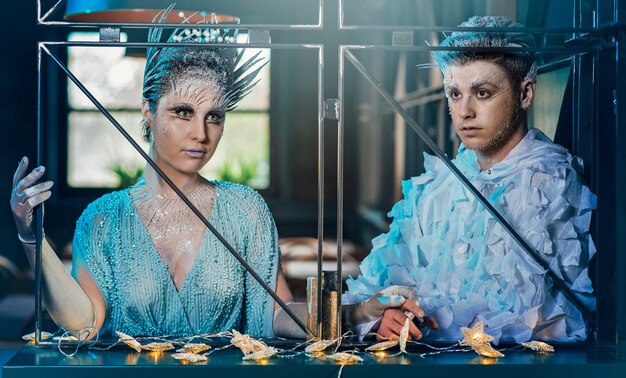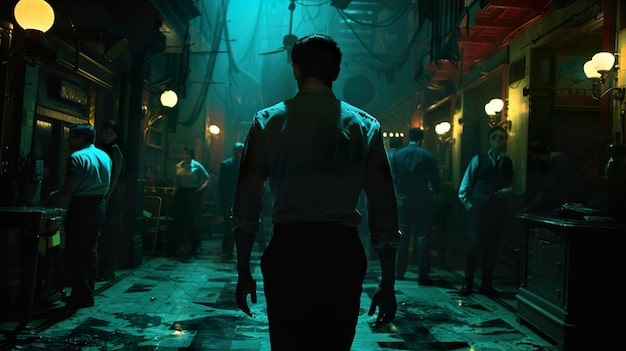The Director’s Cut Dilemma: Exploring Restorations Gone Wrong

The director’s cut dilemma arises when restoring cult classics, as filmmakers often grapple with balancing their original vision against audience expectations and potential commercial appeal, sometimes leading to controversial or unsuccessful revisions.
The allure of revisiting and enhancing a beloved cult classic often proves irresistible to filmmakers. But what happens when the scalpel of restoration cuts too deep, leaving fans feeling betrayed and the film’s legacy tarnished? The director’s cut dilemma: when restoring cult classics goes wrong isn’t just a cautionary tale; it’s a complex exploration of artistic vision, fan expectations, and the fine line between preservation and revisionism.
Understanding the Allure of the Director’s Cut
Director’s cuts have become a staple in the film industry, promising viewers a more complete or authentic vision of a movie. The motivation behind a these cuts is often driven by a desire to restore elements that were previously compromised due to studio intervention, time constraints, or censorship. But what is the initial draw of a director’s cut, and how did it become so prominent in the realm of cult cinema?
The Promise of Unveiled Vision
The primary appeal of a director’s cut lies in the promise of seeing the film as the director originally intended. This can involve restoring deleted scenes, extending existing ones, or altering the film’s pacing or narrative structure. For fans, it’s a chance to delve deeper into the world of the film and gain a greater understanding of the director’s artistic choices.
The Power Dynamics of Filmmaking
The history of cinema is filled with stories of directors clashing with studios over creative control. The director’s cut offers a way to reclaim some of that control, allowing the director to present their vision without the interference of executives or marketing departments. This is particularly appealing for films that were heavily modified or censored during their initial release.

But, sometimes it doesn’t work as intended. Here are a few key points on why some directors cuts are controversial:
- Censorship battles: Director’s cuts often restore content previously cut due to censorship concerns.
- Studio interference: Directors aim to undo studio-mandated changes that diluted their original vision.
- Restoring artistic intent: The cuts give directors a chance to present their work as truly intended, enhancing the narrative.
- Fan engagement: These versions offer fans deeper insights and a more complete experience of the movie.
The allure of the director’s cut is understandable. However, the actual execution can be a mixed bag, particularly when it comes to cult classics where the original imperfections often contributed to the film’s unique charm.
The Pitfalls of Tinkering with Perfection
Cult classics often achieve their status due to a unique blend of factors: their quirky narratives, distinctive visual styles, and even their technical imperfections. When a director revisits these films years later, attempting to “perfect” them, they risk disrupting the delicate balance that made the original so beloved. One of the biggest problems is when they introduce new CGI and/or modern techonology to a project that didn’t have it originally.
The Peril of Over-Polishing
One of the most common criticisms of director’s cuts is the tendency to over-polish the visual aspects of the film. What was once celebrated for its grainy texture or low-budget charm can become sterile and artificial with excessive digital enhancements. This is because the original charm of cult classics often lies in their imperfections and lo-fi charm, which is lost when directors try to smooth everything out.
Narrative Missteps and Unnecessary Additions
Another risk is introducing new narrative elements that clash with the established tone or pacing of the original film. This can include adding scenes that feel out of place, altering character motivations, or changing the ending in a way that alienates fans. Sometimes extra scenes and modern CGI can ruin a cult classic’s originality and impact.
Fans often react negatively due to:
- Loss of Original Charm: Over-polishing can strip away the unique qualities that made the film a cult classic.
- Inconsistent Tone: New additions may not align with the established tone, creating a jarring viewing experience.
- Disrupted Pacing: Altering the film’s pacing can affect its overall rhythm and impact.
- Alienating Changes: Making significant changes to characters or the ending can alienate longtime fans.
The attempt to “improve” a cult classic can inadvertently diminish its appeal. This is why directors need to tread carefully and have a deep understanding of what made the original so special.
Case Studies: Director’s Cuts That Divided Fans
There are several examples of director’s cuts that sparked controversy and divided fans. These case studies offer valuable insights into the challenges and pitfalls of revisiting classic films and highlight the delicate balance between artistic vision and audience expectations. Here we will observe a few that caused controversy.
“Star Wars: Special Edition”
George Lucas’s revisions to the original *Star Wars* trilogy are a prime example of a director’s cut that faced backlash. While some fans appreciated the enhanced visual effects and restored scenes, many felt that the changes detracted from the original’s charm and created inconsistencies with the established lore. The addition of CGI creatures and alterations to iconic scenes were particularly criticized.
“Close Encounters of the Third Kind: Special Edition”
Steven Spielberg’s decision to add a scene inside the mothership in *Close Encounters of the Third Kind: Special Edition* was met with mixed reactions. Some viewers found the scene anticlimactic and unnecessary, while others appreciated the glimpse into the alien world. The controversy highlights the challenge of adding new elements to a film that already had a satisfying conclusion.
“Blade Runner: The Final Cut”
Ridley Scott’s various versions of *Blade Runner* have fueled debates among fans for decades. While *The Final Cut* is generally considered the definitive version, some purists still prefer the theatrical cut with its ambiguous ending and Harrison Ford’s voiceover. The controversies range from the removal of Ford’s voiceover to the inclusion of certain shots. This shows that even seemingly minor changes can have a significant impact on the film’s reception.
These case studies emphasize the importance of preserving what made the original great and of understanding how alterations can change the viewers interpretations.
The Ethics of Altering a Work of Art
Is a director’s cut a legitimate expression of artistic vision, or is it a form of revisionism that disrespects the original work? The concept raises questions about the ownership of art and the extent to which an artist should be allowed to alter their creations after they have been released to the public. When it comes to the ethics of altering a work of art, there are few points in which should be considered.
The Artist’s Right to Revisit
Some argue that a director has the right to revisit their work and make changes that reflect their evolving vision. This perspective suggests that art is a living thing, and that artists should be allowed to refine and improve their creations over time. It sees a director’s cut as an opportunity to correct mistakes, clarify themes, or simply present the film in a way that they find more satisfying.
The Audience’s Connection to the Original
Others argue that cult classics belong to the fans, and that directors should not tamper with the original versions that have become so beloved. This perspective suggests that the audience has a vested interest in preserving the integrity of the film, and that changes can feel like a betrayal of their emotional connection to the work. It sees the original film as a historical artifact that should be preserved for future generations.
Key Takeaways include:
- The Artist’s Right: Claiming directors should have the freedom to revise their work.
- Ownership Debate: Questioning who truly owns a film after its initial release.
- Evolving Vision: Highlighting how director’s cuts represent a director’s current artistic perspective.
- Audience Attachment: Emphasizing the strong emotional ties audiences form with original versions.
The debate over the ethics of altering a work of art is unlikely to be resolved anytime soon. Ultimately, it comes down to balancing the artist’s right to express their vision with the audience’s desire to preserve the integrity of the original creation.
Strategies for Successful Restoration
While some director’s cuts have been met with controversy, others have been praised for enhancing the original film without sacrificing its essence. These successful restorations offer valuable lessons on how to approach the delicate task of revisiting and improving a cult classic. Some restorations improve the film, and there are some strategies that can be used.
Respecting the Source Material
One of the key elements of a successful restoration is a deep respect for the source material. This means understanding what made the original film so special and avoiding changes that would fundamentally alter its tone, themes, or characters. It also means preserving the visual style of the original and avoiding excessive digital enhancements that would make it look too modern.
Collaboration and Feedback
Another important strategy is to involve the original cast and crew in the restoration process. Their insights and perspectives can be invaluable in ensuring that the changes are consistent with the original vision and that they do not alienate fans. Gathering feedback from fans and critics can also help to identify potential issues and make informed decisions about which changes to implement.
A few strategies to consider when successfully restoring a movie:
- Engage Original Team: It involves the original cast and crew to maintain consistency.
- Preserve Key Elements: The team should retain the original tone, themes, and character.
- Seek Fan Feedback: They can gather fans’ feedback to identify potential issues.
- Subtle Enhancements: They should focus on enhancing rather than altering key aspects.
By approaching the restoration process with respect, collaboration, and a clear understanding of the original film’s appeal, directors can create a director’s cut that enhances the viewing experience without betraying the spirit of the original.
The Future of Director’s Cuts and Cult Cinema
As technology continues to evolve and filmmaking practices change, the future of director’s cuts and cult cinema remains uncertain. Will directors continue to revisit and revise their classic films, or will they focus on creating new works that reflect their current artistic vision? Only time will tell. But, how will new technologies affect the cult classics of the fututre?
The Rise of Interactive Storytelling
One potential trend is the rise of interactive storytelling, which would allow viewers to make choices that affect the outcome of the film. This could lead to director’s cuts that are not just longer or more complete, but also more personalized and engaging. Imagine, for example, a director’s cut that allows viewers to choose different character paths or endings, creating a unique experience each time they watch the film.
The Importance of Archival Preservation
Another important consideration is the need for better archival preservation of original film elements. As older films age, they become more vulnerable to damage and degradation. Ensuring that these films are properly preserved is essential for future generations to appreciate and study them. This includes not only preserving the physical film, but also the original scripts, storyboards, and other production materials.
In summary, the future depends on:
- Technology: Considering emerging technologies can offer new storytelling methods.
- Audience Input: The public may get more integrated into the artistic direction over time.
- Cultural shift: Directors and producers might have to adapt practices to maintain fan engagement while maintaining a connection to the original film and intention.
- Preservation Efforts: Archiving original film elements will ensure preservation for posterity.
The director’s cut dilemma will likely remain a topic of debate for years to come. But by approaching these restorations with respect, collaboration, and a clear understanding of the original film’s appeal, directors can create versions that enhance the initial viewing experience without betraying the spirit of the original.
| Key Point | Brief Description |
|---|---|
| 🎬 Original Vision | Director’s cuts often aim to restore their initial creative vision. |
| 🤔 Restoration Risks | Over-polishing can strip away what made the original special. |
| ⚖️ Artistic Ethics | Balancing the director’s rights with the audience’s emotional attachment. |
| ✨ Successful Strategies | Respecting the original and involving the original team are keys to success. |
Retrospective Restoration: The Director’s Cut Dilemma
▼
A director’s cut is a version of a film that reflects the director’s original vision, often including scenes, dialogue, or edits that were removed from the theatrical release due to studio intervention or other constraints.
▼
Some director’s cuts fail because they over-polish the film, remove its original charm, or add elements that clash with the established tone and narrative. This can alienate fans attached to the original version.
▼
Successful restorations require respect for the source material, involving the original cast and crew, and gathering feedback from fans. Directors should enhance rather than fundamentally alter the film’s essence.
▼
Ethical considerations involve balancing the artist’s right to revisit their work with the audience’s emotional connection to the original. Some argue fans have a vested interest in preserving the film’s integrity.
▼
Interactive storytelling could emerge, allowing viewers to make choices that impact the film’s outcome. This could create personalized director’s cuts and more immersive experiences for film fans.
Conclusion
The director’s cut dilemma is a complex issue with no easy answers. While the lure of revisiting and enhancing a beloved film is often strong, it’s vital to recognize the delicate balance between artistic vision and audience expectations. By respecting the source material, collaborating with the original team, and considering the fans’ perspective, directors can navigate the road to restoration and create versions that honor the past while enhancing the viewing experience for all.





